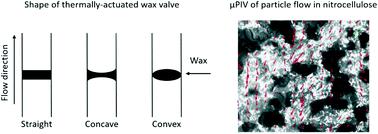Our official English website, www.x-mol.net, welcomes your
feedback! (Note: you will need to create a separate account there.)
Characterization of wax valving and μPIV analysis of microscale flow in paper-fluidic devices for improved modeling and design
Lab on a Chip ( IF 6.1 ) Pub Date : 2022-06-16 , DOI: 10.1039/d2lc00297c Emilie I Newsham 1, 2 , Elizabeth A Phillips 1 , Hui Ma 1 , Megan M Chang 2 , Steven T Wereley 3 , Jacqueline C Linnes 1
Lab on a Chip ( IF 6.1 ) Pub Date : 2022-06-16 , DOI: 10.1039/d2lc00297c Emilie I Newsham 1, 2 , Elizabeth A Phillips 1 , Hui Ma 1 , Megan M Chang 2 , Steven T Wereley 3 , Jacqueline C Linnes 1
Affiliation

|
Paper-fluidic devices are a popular platform for point-of-care diagnostics due to their low cost, ease of use, and equipment-free detection of target molecules. They are limited, however, by their lack of sensitivity and inability to incorporate more complex processes, such as nucleic acid amplification or enzymatic signal enhancement. To address these limitations, various valves have previously been implemented in paper-fluidic devices to control fluid obstruction and release. However, incorporation of valves into new devices is a highly iterative, time-intensive process due to limited experimental data describing the microscale flow that drives the biophysical reactions in the assay. In this paper, we tested and modeled different geometries of thermally actuated valves to investigate how they can be more easily implemented in an LFIA with precise control of actuation time, flow rate, and flow pattern. We demonstrate that bulk flow measurements alone cannot estimate the highly variable microscale properties and effects on LFIA signal development. To further quantify the microfluidic properties of paper-fluidic devices, micro-particle image velocimetry was used to quantify fluorescent nanoparticle flow through the membranes and demonstrated divergent properties from bulk flow that may explain additional variability in LFIA signal generation. Altogether, we demonstrate that a more robust characterization of paper-fluidic devices can permit fine-tuning of parameters for precise automation of multi-step assays and inform analytical models for more efficient design.
中文翻译:

纸流体装置中蜡阀的表征和微尺度流动的 μPIV 分析,以改进建模和设计
纸流体设备因其成本低、易于使用且无需设备即可检测目标分子而成为床边诊断的流行平台。然而,它们由于缺乏敏感性并且无法整合更复杂的过程(例如核酸扩增或酶信号增强)而受到限制。为了解决这些限制,之前已经在纸流体装置中实施了各种阀门来控制流体阻塞和释放。然而,由于描述驱动测定中生物物理反应的微尺度流动的实验数据有限,将阀门整合到新设备中是一个高度迭代、耗时的过程。在本文中,我们对不同几何形状的热驱动阀进行了测试和建模,以研究如何在 LFIA 中更轻松地实现它们,并精确控制驱动时间、流量和流动模式。我们证明,仅使用整体流量测量无法估计高度可变的微尺度特性以及对 LFIA 信号发展的影响。为了进一步量化纸流体装置的微流体特性,使用微粒图像测速法来量化穿过膜的荧光纳米颗粒流,并证明了与整体流的不同特性,这可以解释 LFIA 信号生成中的额外变化。共,
更新日期:2022-06-16
中文翻译:

纸流体装置中蜡阀的表征和微尺度流动的 μPIV 分析,以改进建模和设计
纸流体设备因其成本低、易于使用且无需设备即可检测目标分子而成为床边诊断的流行平台。然而,它们由于缺乏敏感性并且无法整合更复杂的过程(例如核酸扩增或酶信号增强)而受到限制。为了解决这些限制,之前已经在纸流体装置中实施了各种阀门来控制流体阻塞和释放。然而,由于描述驱动测定中生物物理反应的微尺度流动的实验数据有限,将阀门整合到新设备中是一个高度迭代、耗时的过程。在本文中,我们对不同几何形状的热驱动阀进行了测试和建模,以研究如何在 LFIA 中更轻松地实现它们,并精确控制驱动时间、流量和流动模式。我们证明,仅使用整体流量测量无法估计高度可变的微尺度特性以及对 LFIA 信号发展的影响。为了进一步量化纸流体装置的微流体特性,使用微粒图像测速法来量化穿过膜的荧光纳米颗粒流,并证明了与整体流的不同特性,这可以解释 LFIA 信号生成中的额外变化。共,











































 京公网安备 11010802027423号
京公网安备 11010802027423号